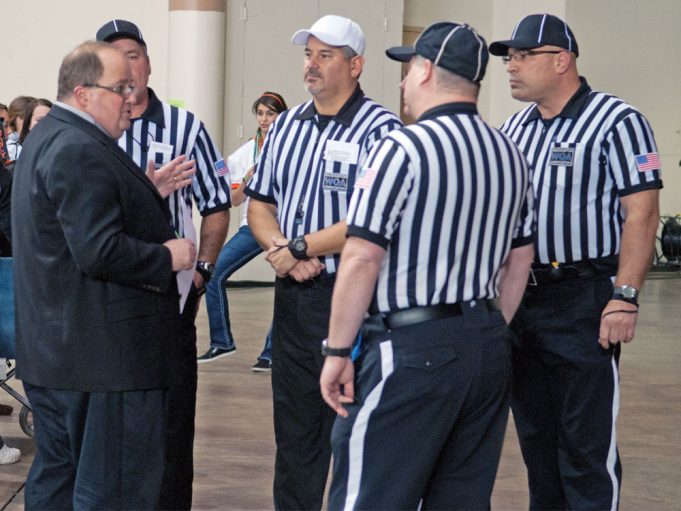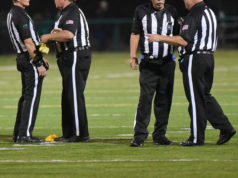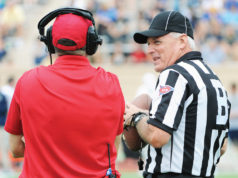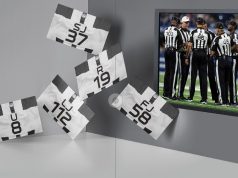What to Say to Whom and When to Say It
Assuming a basic knowledge of football rules and mechanics, communication is arguably the greatest single attribute of an official. A coach’s evaluation form without that item is rare. Most coaches will list communication among the top three things they look for in an official. Once the whistle blows, the people in stripes are more communicators than officials. All available tools must be used to look good, especially speech and body language. The following is a look at the different groups an official must communicate with in what is arguably a descending order of importance.
Coaches.
Coaches have a need and a right to know what is going on in a game. The sideline is not a good vantage point (albeit most coaches won’t admit that). Consequently, they deserve to be informed. Signals are one form of communication, but in many cases, the personal approach is preferable. At a minimum, when a foul is called, the coach of the offending team should be told the number of the fouling player. If the officials don’t have the number, their credibility will be questioned. In the absence of a number, a description of the offender such as, “There was movement on the right side of the line,” is better than, “I dunno.”
Unusual situations must be explained to the head coach. In many circumstances, the explanation can be tendered by the sideline official. On others, such as a reversal of a call or an apparent reversal, it may be best if the referee gives the explanation.
Crew members.
Officials who work with the same crew all season have an advantage. They know each other much better and can be more open with one another. Long road trips and social events are a good way to get to know crew members. Taking responsibility for your actions and providing encouragement to crewmates is a plus. Putdowns should be avoided. There is a fine line between putdowns and chiding. Locally, there are two officials who have been friends for more than 15 years. They delight in criticizing each other, usually over trivial matters, before, during and after a game. They are the exception. Most of the comments they make to each other would be resented by a third person.
Understanding your crewmates is important when there may be differing opinions and a quick decision must be made. The most frequent is probably when there is a question as to whether the offense or defense fouled. If an offensive lineman lifts up from his three-point stance, was it a false start or did the defense first encroach (NFHS) or induce the act (NCAA)? When there is a controversial play and two officials make different calls, egos must be put aside.
Players.
Players are all students in a learning environment. Keeping that in mind can only help. Admonishing players for fouls is not one of an official’s duties. Never throw a flag with vengeance. The safest way to address a player is by number. “Captain” is acceptable when applicable, but “Hey, you” or “Son” should be avoided.
As a general rule, the less you say to players, the better off you’ll be. Building rapport with the participants is part of good officiating. Under no circumstances, though, should you fraternize, criticize or threaten. Avoid “coaching” players, but don’t let that deter you from cautioning a player. Letting a player know his actions are close to being interpreted as a violation of the rules is smart officiating.
There is a fine line between a warning and a threat. For example, if an offensive lineman briefly grabs a defender’s jersey, a threat would be, “If I see you grabbing jerseys again, it’ll cost you 10 yards.” Instead, question the player in a mild tone, “You didn’t grab his jersey, did you?” No matter how he replies, he knows he is being watched and can expect a flag if he does it again. If the message had been delivered as either a threat or an accusation and overheard by an opponent, the response could very well be, “If you saw it, why didn’t you flag it?”
Supervisor.
In some conferences, the commissioner supervises the officials; in others, a separate individual is hired. At the prep level, there probably won’t be a supervisor. Instead, officials may have to deal with league or association assigners and perhaps a state commissioner for postseason play. All those individuals must be treated courteously and with respect, regardless of their degree of football competence. In almost all cases, state associations will publicly support officials whether they like what was ruled or not. However, regardless of whether they are dual-hatted or not, it may not be politically feasible for them to do battle with a blowhard coach on your behalf.
Spectators.
Officials communicate with the fans via signals and it should stop there. If a spectator interferes with the game, the situation should be referred to the game administrator or security personnel. Generally, officials should not deal directly with spectators. At the lower levels, where spectators may be allowed to stand on the sidelines, it’s OK to answer a reasonable question.
Media.
There is not much to be said about the media because officials ought not say much to reporters. If the game was well-officiated, the press will show no interest. The NFL and major college conferences strictly limit contact between officials and the media during the season. Inquiries usually must be submitted to the league office. At the local level, statements are apt to do more harm than good. Remember, silence can’t be misquoted.
What's Your Call? Leave a Comment:
Note: This article is archival in nature. Rules, interpretations, mechanics, philosophies and other information may or may not be correct for the current year.
This article is the copyright of ©Referee Enterprises, Inc., and may not be republished in whole or in part online, in print or in any capacity without expressed written permission from Referee. The article is made available for educational use by individuals.


















